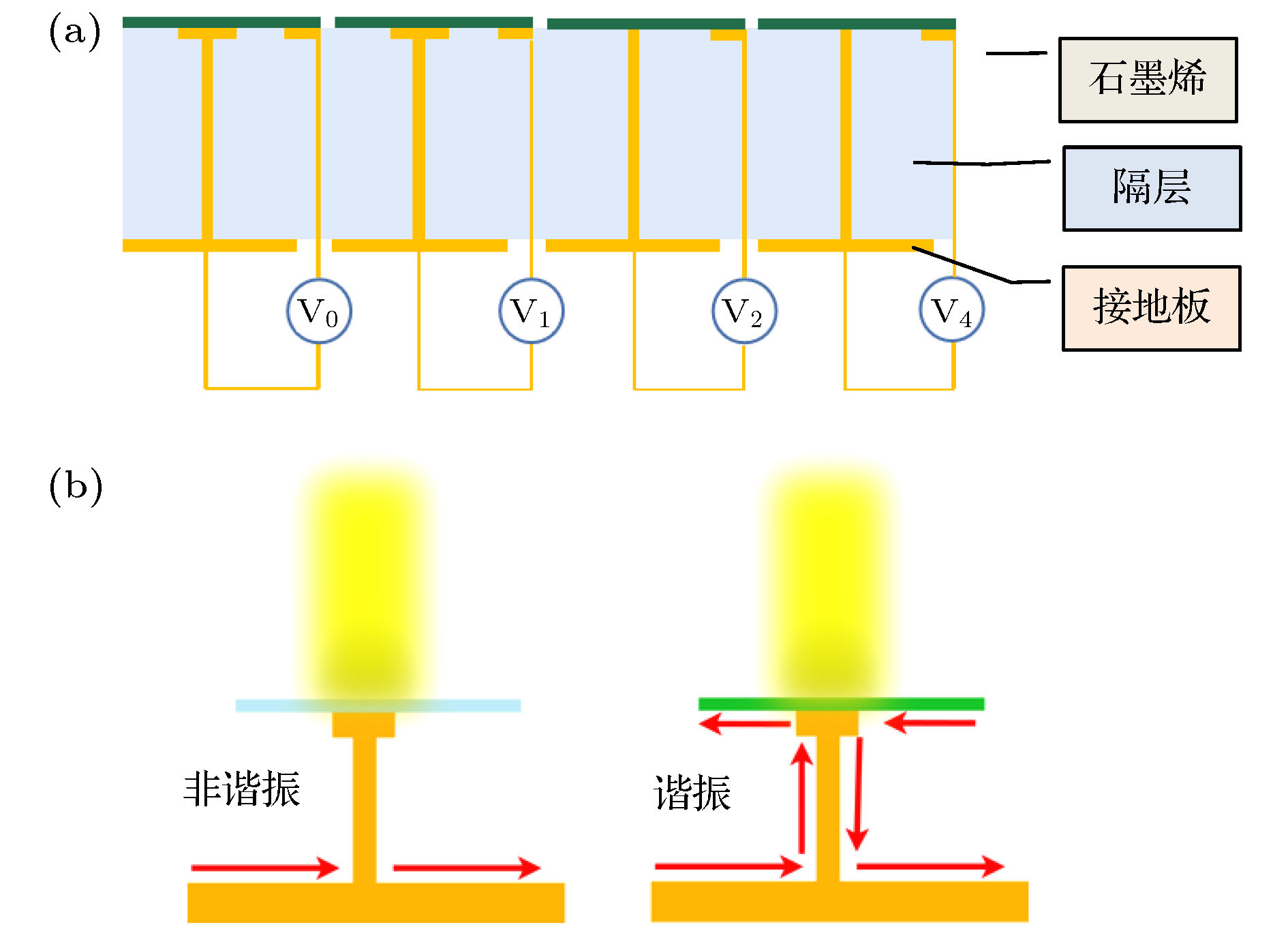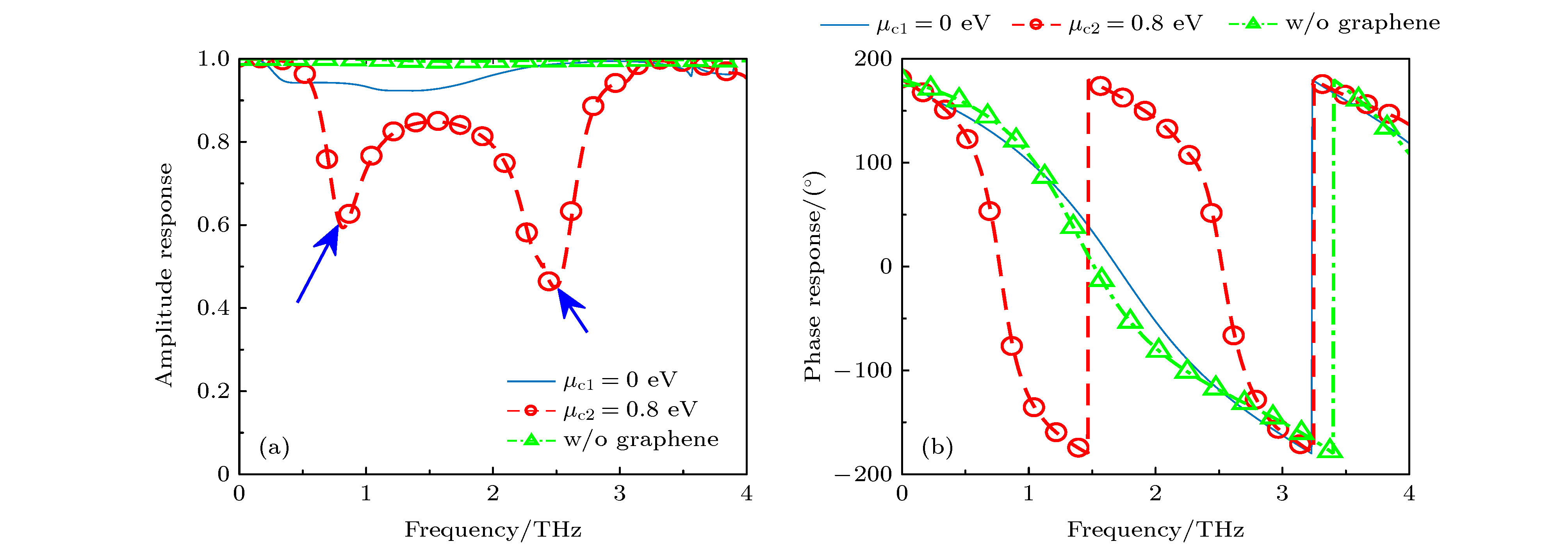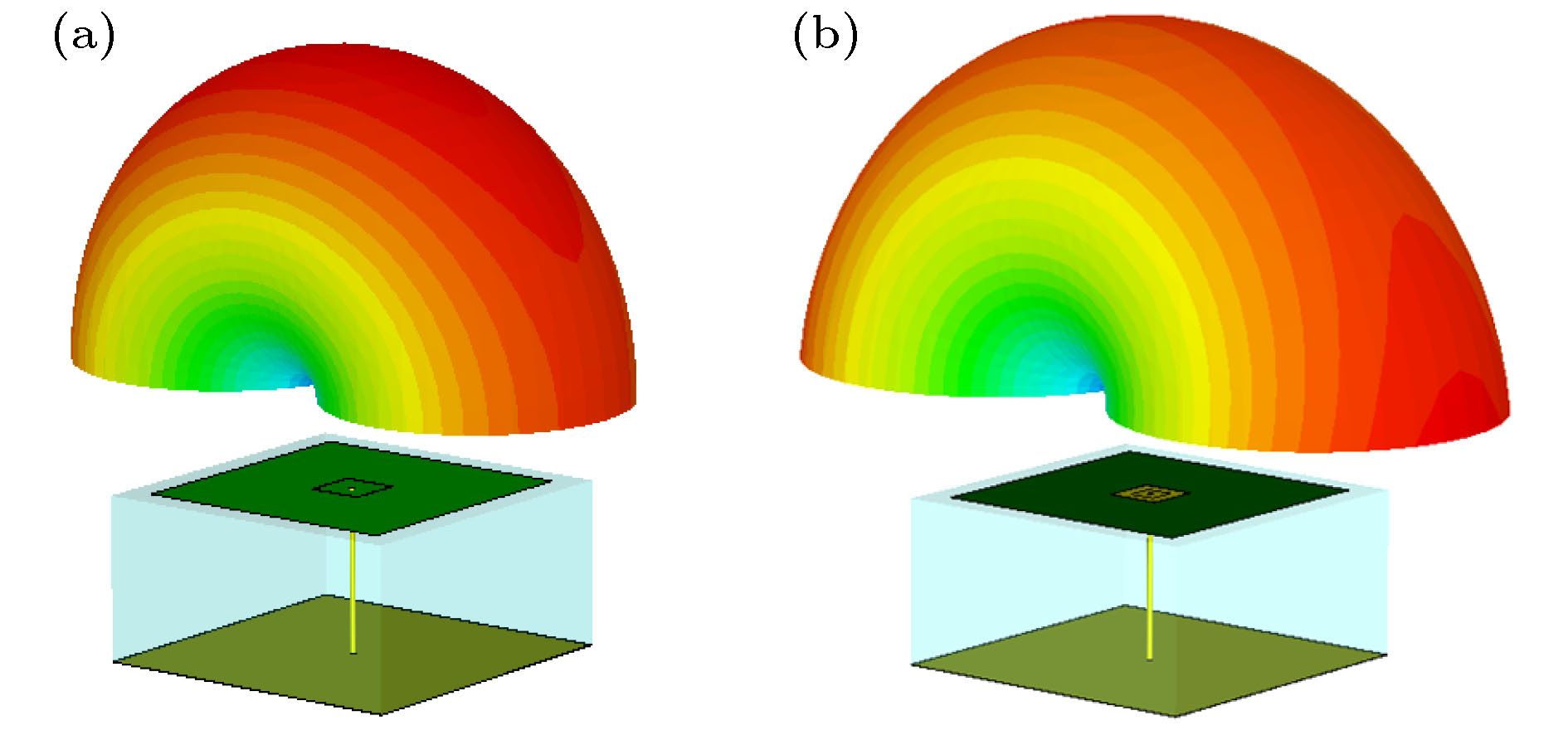-
Electromagnetic diffusion surface can reduce the radar cross section, thus profiting stealth of targets. Terahertz diffusion surface has a wide prospect in the field of next-generation radar and communication, promising to act as a kind of intelligent smart skin. In this paper, utilizing the excellent tunable properties of graphene in the terahertz band, a hybrid structure of graphene and metal which has inverse phase response of reflecting waves is proposed. The reflection phase switches in the mechanism of resonant modes and can be controlled efficiently by the bias voltage. Meanwhile, unlike metal materials, graphene has a non-negligible loss characteristic, which leads the response amplitudes corresponding to the two different switching states to be inconsistent with each other. According to the interference and superposition principle of electromagnetic field, it is not conducive to eliminating the coherent far-field, leading to an unsatisfactory diffusion result. In this paper, we present a “molecular” structure by secondary combination of the above-mentioned reverse phase element states, and take it as the basic element of the diffusion surface. Finally, we use particle swarm optimization to optimize the arrangement of “molecular” structures. The final diffusion surface consists of a combinatorial design of “molecules” rather than randomly distributed reflection units. In addition, molecules designed artificially have similar amplitude responses but different phase responses, which improves the convergence speed and reduces the computation quantity during algorithm evolution. The method of designing molecular structure, described in this paper, is simple, rapid and widely applicable, which effectively improves the amplitude-to-phase modulation ability of graphene metasurface against electromagnetic waves. When diffuse reflection optimization is applied to most of graphene metasurfaces, the method described in this paper can achieve the results that are the same as or even better than the results after a large number of iterations of traditional particle swarm optimization in the most computation-efficient manner. The results show that the dynamic diffusion surface designed by this method has the advantages of fast convergence speed and small far-field peak.
-
Keywords:
- graphene /
- terahertz /
- diffuse reflection /
- particle swarm optimization
[1] Zhao J, Cheng Q, Wang X K, Yuan M J, Zhou X, Fu X J, Qi M Q, Liu S, Chen H B, Zhang Y 2016 Adv. Opt. Mater. 4 1773
 Google Scholar
Google Scholar
[2] Benz A, Krall M, Schwarz S, Dietze D, Detz H, Andrews A M, Schrenk W 2014 Sci. Rep. 4 4296
 Google Scholar
Google Scholar
[3] Nagatsuma T 2011 IEICE Electronic Exp. 8 1127
 Google Scholar
Google Scholar
[4] Federici J, Moeller L 2010 J. Appl. Phys. 107 111101
 Google Scholar
Google Scholar
[5] Alves F, Grbovic D, Kearney B, Karunasiri G 2012 Opt. Lett. 37 1886
 Google Scholar
Google Scholar
[6] Iwaszczuk K, Strikwerda A C, Fan K, Zhang X, Averitt R D, Jepsen P U 2012 Opt. Express 20 635
 Google Scholar
Google Scholar
[7] 李思佳, 曹祥玉, 高军, 郑秋容, 陈红雅, 赵一, 杨群 2013 62 194101
 Google Scholar
Google Scholar
Li S J, Cao X Yu, Gao J Z, Qiu R Z, Yi Y Q 2013 Acta Phys. Sin. 62 194101
 Google Scholar
Google Scholar
[8] Cheng C W, Abbas M N, Chiu C W, Lai K T, Shih M H, Chang Y C 2012 Opt. Express 20 10376
 Google Scholar
Google Scholar
[9] Zhao Y, Cao X, Gao J, Sun Y, Yang H, Liu X, Zhou Y, Han T, Chen W 2016 Sci Rep 6 23896
 Google Scholar
Google Scholar
[10] 闫昕, 梁兰菊, 张雅婷, 丁欣, 姚建铨 2015 64 158101
 Google Scholar
Google Scholar
Yan X, Liang L J, Zhang Y T, Ding X, Yao J Q 2015 Acta Phys. Sin. 64 158101
 Google Scholar
Google Scholar
[11] Cui T J, Qi M Q, Wan X, Zhao J, Cheng Q 2014 Light-Sci. Appl. 3 218
 Google Scholar
Google Scholar
[12] Liu X, Gao J, Xu L, Cao X, Zhao Y, Li S 2017 IEEE Antennas Wirel. Propag. Lett. 16 724
 Google Scholar
Google Scholar
[13] Zhang H, Lu Y, Su J, Li Z, Liu J, Yang Y 2017 Electron. Lett. 53 187
 Google Scholar
Google Scholar
[14] Zhao J, Cheng Q, Wang T Q, Yuan W, Cui T J 2017 Opt. Express 25 1050
 Google Scholar
Google Scholar
[15] Sui S, Ma H, Lv Y, Wang J, Li Z, Zhang J, Xu Z, Qu S 2018 Opt. Express 26 1443
 Google Scholar
Google Scholar
[16] Zhuang Y, Wang G, Liang J, Zhang Q 2017 IEEE Antennas Wirel. Propag. Lett. 16 2606
 Google Scholar
Google Scholar
[17] Qiu L, Xiao G, Kong X, Xiong C 2019 Opt. Express 27 21226
 Google Scholar
Google Scholar
[18] Gao L H, Cheng Q, Yang J, Ma S, Zhao J, Liu S, Chen H, He Q, Jiang W X, Ma H F 2015 Light-Sci. Appl. 4 324
 Google Scholar
Google Scholar
[19] Wang J, Lu W B, Li X B, Liu J L 2016 IEEE Photonics Technol. Lett. 28 971
 Google Scholar
Google Scholar
[20] 李小兵, 陆卫兵, 刘震国, 陈昊 2018 67 184101
 Google Scholar
Google Scholar
Li X B, Lu W B, Liu Z G, Chen H 2018 Acta Phys. Sin. 67 184101
 Google Scholar
Google Scholar
[21] 张银, 冯一军, 姜田, 曹杰, 赵俊明, 朱博 2017 66 204101
 Google Scholar
Google Scholar
Zhang Y, Feng Y J, Jiang T, Cao J, Zhao J M, Zhu B 2017 Acta Phys. Sin. 66 204101
 Google Scholar
Google Scholar
-
表 1 传统PSO算法与本文提出的方法的效果对比
Table 1. Effect comparison between the traditional PSO and the proposed method in this paper.
阵列
规模传统PSO 本文方法 远场峰
值/(V·m–1)优化效
率/dB远场峰
值/(V·m–1)优化效
率/dB9 × 9 10.08 –16.80 6.72 –21.00 18 × 18 27.60 –20.74 19.60 –23.71 27 × 27 45.00 –23.54 34.00 –25.97 表 2 传统PSO算法与本文提出的方法的粒子分布比较
Table 2. Particle distribution comparisons between the traditional PSO and the proposed method in this paper.
阵列规模 粒子方差 粒子均值 传统PSO 本文方法 传统PSO 本文方法 9 × 9 1.12 0.19 11.34 7.09 18 × 18 2.04 1.65 28.45 21.67 27 × 27 28.69 10.25 49.57 38.04 -
[1] Zhao J, Cheng Q, Wang X K, Yuan M J, Zhou X, Fu X J, Qi M Q, Liu S, Chen H B, Zhang Y 2016 Adv. Opt. Mater. 4 1773
 Google Scholar
Google Scholar
[2] Benz A, Krall M, Schwarz S, Dietze D, Detz H, Andrews A M, Schrenk W 2014 Sci. Rep. 4 4296
 Google Scholar
Google Scholar
[3] Nagatsuma T 2011 IEICE Electronic Exp. 8 1127
 Google Scholar
Google Scholar
[4] Federici J, Moeller L 2010 J. Appl. Phys. 107 111101
 Google Scholar
Google Scholar
[5] Alves F, Grbovic D, Kearney B, Karunasiri G 2012 Opt. Lett. 37 1886
 Google Scholar
Google Scholar
[6] Iwaszczuk K, Strikwerda A C, Fan K, Zhang X, Averitt R D, Jepsen P U 2012 Opt. Express 20 635
 Google Scholar
Google Scholar
[7] 李思佳, 曹祥玉, 高军, 郑秋容, 陈红雅, 赵一, 杨群 2013 62 194101
 Google Scholar
Google Scholar
Li S J, Cao X Yu, Gao J Z, Qiu R Z, Yi Y Q 2013 Acta Phys. Sin. 62 194101
 Google Scholar
Google Scholar
[8] Cheng C W, Abbas M N, Chiu C W, Lai K T, Shih M H, Chang Y C 2012 Opt. Express 20 10376
 Google Scholar
Google Scholar
[9] Zhao Y, Cao X, Gao J, Sun Y, Yang H, Liu X, Zhou Y, Han T, Chen W 2016 Sci Rep 6 23896
 Google Scholar
Google Scholar
[10] 闫昕, 梁兰菊, 张雅婷, 丁欣, 姚建铨 2015 64 158101
 Google Scholar
Google Scholar
Yan X, Liang L J, Zhang Y T, Ding X, Yao J Q 2015 Acta Phys. Sin. 64 158101
 Google Scholar
Google Scholar
[11] Cui T J, Qi M Q, Wan X, Zhao J, Cheng Q 2014 Light-Sci. Appl. 3 218
 Google Scholar
Google Scholar
[12] Liu X, Gao J, Xu L, Cao X, Zhao Y, Li S 2017 IEEE Antennas Wirel. Propag. Lett. 16 724
 Google Scholar
Google Scholar
[13] Zhang H, Lu Y, Su J, Li Z, Liu J, Yang Y 2017 Electron. Lett. 53 187
 Google Scholar
Google Scholar
[14] Zhao J, Cheng Q, Wang T Q, Yuan W, Cui T J 2017 Opt. Express 25 1050
 Google Scholar
Google Scholar
[15] Sui S, Ma H, Lv Y, Wang J, Li Z, Zhang J, Xu Z, Qu S 2018 Opt. Express 26 1443
 Google Scholar
Google Scholar
[16] Zhuang Y, Wang G, Liang J, Zhang Q 2017 IEEE Antennas Wirel. Propag. Lett. 16 2606
 Google Scholar
Google Scholar
[17] Qiu L, Xiao G, Kong X, Xiong C 2019 Opt. Express 27 21226
 Google Scholar
Google Scholar
[18] Gao L H, Cheng Q, Yang J, Ma S, Zhao J, Liu S, Chen H, He Q, Jiang W X, Ma H F 2015 Light-Sci. Appl. 4 324
 Google Scholar
Google Scholar
[19] Wang J, Lu W B, Li X B, Liu J L 2016 IEEE Photonics Technol. Lett. 28 971
 Google Scholar
Google Scholar
[20] 李小兵, 陆卫兵, 刘震国, 陈昊 2018 67 184101
 Google Scholar
Google Scholar
Li X B, Lu W B, Liu Z G, Chen H 2018 Acta Phys. Sin. 67 184101
 Google Scholar
Google Scholar
[21] 张银, 冯一军, 姜田, 曹杰, 赵俊明, 朱博 2017 66 204101
 Google Scholar
Google Scholar
Zhang Y, Feng Y J, Jiang T, Cao J, Zhao J M, Zhu B 2017 Acta Phys. Sin. 66 204101
 Google Scholar
Google Scholar
Catalog
Metrics
- Abstract views: 7642
- PDF Downloads: 103
- Cited By: 0















 DownLoad:
DownLoad:







